SPG-82 / SG-82 grenade launcher
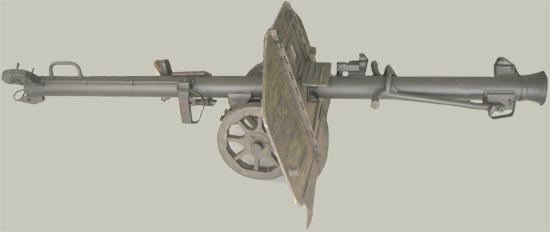
LNG-82
In 1942, in the SKB No 36 of the People’s Commissariat of the Oil Industry of the USSR under the leadership of A.P. Ostrovsky and Chief Designer N.G. Grigoryan, work began on the creation of an 82-mm mounted grenade launcher using a rocket scheme. Later, P.P. Shumilov joined this work.
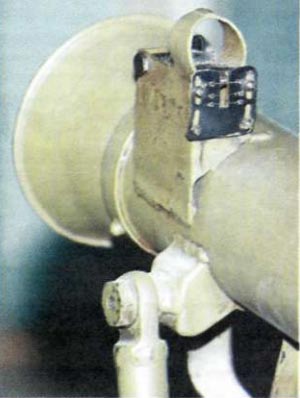
SPG-82 / SG-82 grenade launcher front sight
Initially, a rotating turbojet grenade was developed for this grenade launcher at NII-6 of the People’s Commissariat of Ammunition. However, its insufficient armor penetration, caused by the rotation of the grenade at high speed and, as a result, the deformation and spraying of the cumulative jet, led to the fact that in 1944 its development was abandoned and switched to the creation of a non-rotating feathered armor-piercing grenade of cumulative action with a new type of jet engine. This engine had a short operating time for the powder charge to burn in the barrel of the grenade launcher, and accordingly high working pressure in the combustion chamber and required a strong body.
Until the end of World War II, the new grenade launcher was tested, and then its refinement.
In 1950, this complex, consisting of the 82-mm SPG-82 mounted anti-tank grenade launcher and the PG-82 caliber anti-tank anti-tank grenade, was adopted by the Soviet Army.
The SPG-82 mounted anti-tank grenade launcher had a smooth thin-walled barrel, without rifling, consisting of two parts: muzzle and breech, which were connected to each other by a coupling.
A self-cocking firing mechanism, a sighting device and a shoulder rest were attached to the barrel.
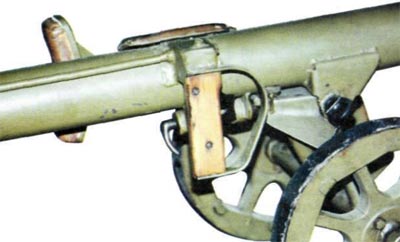
trigger handle of the SPG-82 / SG-82 grenade launcher
The barrel was mounted on a wheeled mount, which made it possible to transport the grenade launcher on the battlefield and install the barrel in a combat or traveling position.
To protect the crew from the action of powder gases, the grenade launcher had a light folding shield and a protective apron under it. In addition, a special nozzle was attached to the muzzle of the barrel - a gas trap. The glazed viewing windows in the shield were automatically blocked by protective metal shutters when fired.
The grenade launcher was serviced by a crew of three people: a gunner, a loader and a grenade carrier.
| LNG-82 | SG-82 | |
|---|---|---|
| Ammunition used | PG-82 | PG-82 |
| OG-82 | ||
| Caliber, mm | 82 | |
| Weight, kg |
- grenade launchers
- PG-82 grenades
- OG-82 grenades|38
4.54
-----|38
4.54
4.95|
|Sighting range, m - PG-82 grenade
- OG-82 grenade|300
-----|300
700|
|Range of direct shot, m
PG-82 grenade|200|
|Armor penetration, mm
by PG-82 grenade|175|
|Combat rate of fire, rounds/min|6|
The SPG-82 grenade launcher was loaded from the breech of the barrel. Aiming was carried out manually using a mechanical sight, while the barrel rested on the mount, and the gunner rested a special stop on the shoulder, holding the trigger handle with his right hand.
The weight of the SPG-82 grenade launcher with a mount was 38 kg, which was many times less than the weight of conventional artillery pieces of this caliber. The direct shot range of the mounted grenade launcher was twice as long as the direct shot range of the RPG-2 hand-held anti-tank grenade launcher and was 200 m. The PG-82 grenade weighed 4.5 kg and provided armor penetration of 175 mm.
The PG-82 anti-tank grenade consisted of a warhead with a shaped charge with a rupor-shaped steel funnel, a jet engine with a stabilizer of six rigid feathers and an aerodynamic ring, as well as a fuse and a fuse. Tubular nitroglycerin powder is used as a charge in the jet engine, which provides stable operation in summer and winter conditions.
When fired, the grenade received speed under the influence of the reactive force of the engine, powder gases flowed back from the nozzle of the engine and then through the open breech of the barrel, which balanced the recoil. The operation of the jet engine continued in the section of the trajectory after the grenade flew out of the barrel, so the weapon was equipped with a protective apron.

PG-82 grenade (top) and OG-82 grenade (bottom)
Subsequently, in order to expand the scope of application for the grenade launcher, the OG-82 fragmentation grenade was developed, which also had a jet engine. The fragmentation grenade expanded the combat capabilities of the grenade launcher, allowing, in addition to fighting tanks, to successfully solve the tasks of destroying enemy fire weapons and manpower.
The new grenade launcher, using PG-82 cumulative grenades and OG-82 fragmentation grenades, received the designation SG-82 (without the letter “P”).
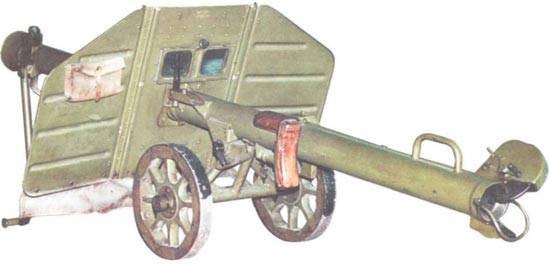
SG-82
Mounted 82-mm grenade launchers were on duty in the artillery battery of the motorized rifle battalion.
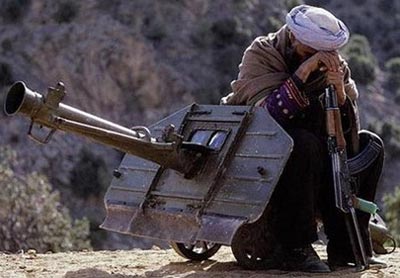
SG-82
used in Afghanistan
Simultaneously with the 82 mm SPG-82 / SG-82 mounted grenade launcher, a more powerful 122 mm SPG-122 mounted anti-tank grenade launcher was developed, later renamed SG-122 during modifications, which has a similar design and action.
The SPG-122 had a mass of 44 kg, a direct shot range of 200 m, a shaped-charge grenade with a jet engine of 6.5 kg, and armor penetration of 300 mm.
Comparative tests of both grenade launcher systems showed that they were equivalent in terms of the probability of hitting the target and in terms of reliability of operation. The lower weight of the SPG-82 grenade launcher and grenades for it significantly increased its maneuverability and facilitated operation during combat. The PG-82 anti-tank grenade of the SPG-82 grenade launcher had less armor penetration than that of the 122 mm grenade launcher, but it was quite sufficient to destroy all armored vehicles of that time. That is why it was decided to put all the design documentation for the LNG-122 complex in reserve.
As a result, neither the SPG-122 nor the SG-122 were adopted by the Soviet army.
Later, on the basis of the SG-82 and SG-122 grenade launchers, 82-mm and 107-mm recoilless guns, named B-10 and B-11, were developed and adopted in 1954.
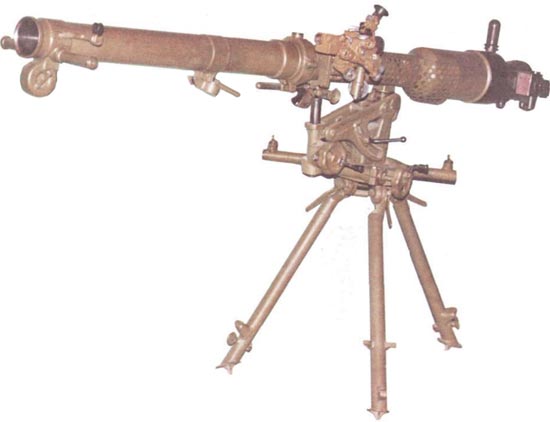
B-10 recoilless gun